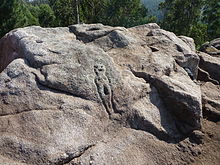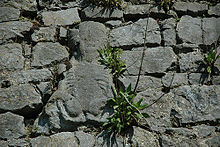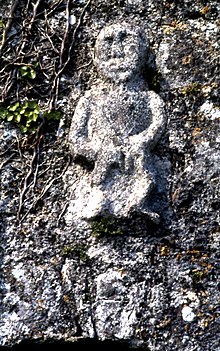Sheela-na-gig

As Sheela-na-Gig ( Irish Síle na gcíoch ) stone reliefs of female figures are referred to in the Irish-English language area, who present their mostly exaggerated vulva .
Distribution and name

The 140 Sheela-na gigs still preserved in their original location are on the outside walls of churches , castles and buildings in Ireland (99) and Great Britain (41). Only a few are accompanied by male figures or can be found on non-sacred buildings. The name was first used by the Royal Irish Academy in the Proceedings of the Royal Irish Academy 1840-44 published and reported as prevailing local name for a figure on the gable wall of a church in Rochestown (no. T17) in the Irish county of Tipperary was appropriate , but is missing today. This name was also mentioned in 1840 by the early Celtologist and member of the Ordnance Survey Ireland , John O'Donovan . He was referring to a figure at a church in the same county. There is disagreement about the origin and meaning of the name. According to Eamonn Kelly, curator at the National Museum of Ireland in Dublin, the name comes naturally from Irish , originally either Sighle na gcíoch ("old witch with breasts") or Síle ina giob ("Sheila [name of an old woman] on her bottom. " "). Birkhan translates Sheela-na-gig as “Julia with the breasts”, but points out that this name is actually rather incorrect.
Views on the origin and purpose of the Sheelas
After James Jerman and Anthony Weir

According to James Jerman and Anthony Weir , the figures were first created in the 11th century on the Iberian Peninsula (Moura Pena Furada) and France . They did not reach Britain and Ireland until the 12th century . They adopted the results of the research started by Jørgen Andersen . Eamonn Kelly pointed to the distribution of sheelas in Ireland to support the same theory: almost all of the sheelas preserved at their original location are found in areas of Ireland conquered by Anglo-Normans in the 12th and 13th centuries . In the areas that remained in the hands of local rulers, there are fewer Sheelas. Weir and Jerman argue in their work Images of Lust that the attachment of the Sheela-na gigs to churches and their ugliness perceived according to medieval norms indicates that they portray female lust as abhorrent and sinful . It is believed that the small sculptures were designed to keep death and evil away.

After Joanne McMahon and Jack Roberts
According to the theory of Joanne McMahon and Jack Roberts, the images are evidence of a pre-Christian fertility cult . To support this claim they refer, for example, to the differences in the materials and style of the sheelas and the buildings that support them. In addition, some of the Sheelas are turned to the side, which indicates that they were taken over from previously existing older structures into early Christian ones . There are differences between "continental" figures of an exhibitionist character and the Irish Sheelas. In Ireland and Great Britain there is also a lack of accompaniment by male figures, as is more common in continental figures. The figures are also more curved and are more reminiscent of contortionists .
The representation of the promiscuity of the pre-Christian goddess of fertility is not limited to Irish representations, even if some cannot be surpassed in terms of clarity. Today it looks as if the reforms of the Irish Church, which only began with the Synod of Rathbreasail in 1111 and continued in Kells in 1152, also heralded the end of the Sheelas. Ireland, always referred to as a cornerstone of Christianity, was not under the influence of Rome until the 12th century and quickly escaped it again when the British conquerors destroyed around 400 monasteries and many churches in the 17th century. The weakened clergy organized the resistance. Mass Rocks and Penal churches are the evidence of secret worship services in occupied Ireland. A fight against the traditional pagan ideas would have turned into a war on two fronts. We can still find thousands of holy springs and wishing trees here that have their secret following or have become Christianized places.
The myth that goes with Robert's version
The pre-Christian goddess of love, which has its equivalent in the Nordic Freya , of which there is a comparatively reserved depiction on a Gotland picture stone , stood for luck, success, fertility and health. According to old Irish legends, a woman appears to every future king as an ugly, lustful witch and tries to seduce him. If she succeeds, she becomes a beautiful woman and gives her success and his reign her blessings. Sheelas urge copulation with a clear gesture; therefore, at least in the official reading of the Church, the meaning of the openly shown libido had to change. So they were seen by the Irish clergy, who were obviously less moralistic at the time, in their traditional mission, namely as a good luck charm. The crescent moon that encloses the right eye of the Sheela of Ballinacarriga in County Cork marks her as a granddaughter of the goddesses Dana and Brigid. J. Roberts even goes as far as Indian Kali , which is represented as Kalika in a similar way. Her Gaelic name was Cailleach. She is considered the primordial mother of the nations. Compare the interpretation of the painting The Origin of the World .
Continental European examples
Similar figures appear on continental European churches and castles of the Middle Ages, especially the Romanesque period - mostly on console friezes or on misericords , more rarely on capitals . Given that they were almost exclusively placed outdoors, they served - according to today's interpretation - to ward off evil spirits, i.e. they had a disastrous, apotropaic function. When it comes to Gothic misericords, on the other hand, they are more to be understood as grotesquely frivolous gimmicks.
In front of the Ponte de Rialto in Venice, on the left house, there is such a stone figure at the top corner.
Château de Caen , Normandy, France
Colegiata de Cervatos , Cantabria , Spain
Ermita de San Salvador , Santibáñez de Esgueva , Spain
St-Materne Basilica , Walcourt , Belgium
Castello Sforzesco , Milan, Italy
Glucsburgh in Goslar
music
Sheela-Na-Gig is also the title of a song by PJ Harvey that appeared on the album Dry (1992) and was released as a single that same year .
See also
literature
- Jørgen Andersen: The Witch on the Wall. Medieval Erotic Sculpture in the British Isles. Rosenkilde and Bagger et al., Copenhagen 1977, ISBN 0-04-940052-5 .
- Maureen Concannon: The Sacred Whore. Sheela, Goddess of the Celts. Collins Press, Cork 2004, ISBN 1-903464-52-8 .
- Ronald Hutton: The Pagan Religions of the Ancient British Isles. Their Nature and Legacy. Blackwell, Oxford et al. 1991, ISBN 0-631-17288-2 .
- Eamonn P. Kelly: Sheela-Na-Gigs. Origins and Functions. Country House, Dublin 1996, ISBN 0-946172-51-X .
- Joanne McMahon, Jack Roberts: The Sheela-Na-Gigs of Ireland & Britain. The divine hag of the Christian Celts. An illustrated guide. Mercier Press, Cork et al. 2001, ISBN 1-85635-294-3 (With list of locations and drawings of Sheela-na gigs in Ireland and Great Britain).
- Anthony Weir, James Jerman: Images of Lust: Sexual Carvings on Medieval Churches. Batsford, London 1986, ISBN 0-7134-5110-6 .
Web links
- Druids to Christians. on iol.ie
- Overview of Sheela-na gigs in Great Britain on SheelaNaGig.org
- Ireland's Sheela Na Gigs on irelands-sheelanagigs.org - Comprehensive overview of the Irish Sheela-na gigs
- Goddess or Queen? on indigogroup.co.uk - The enigmatic Braunston Goddess
- Sheela von Abbeylara engl. with picture
- Sheela von Ballinacarriga engl. with picture
This article is based in part on the translation of the English-language article of the same name .
Individual evidence
- ↑ Helmut Birkhan : Celts. Images of their culture. = Celts. Images of their culture. Verlag der Österreichischen Akademie der Wissenschaften, Vienna 1999, ISBN 3-7001-2814-2 , p. 41, p. 300, pictures 513-515.
- ↑ do scomesse par el ponte. Retrieved April 15, 2019 .






